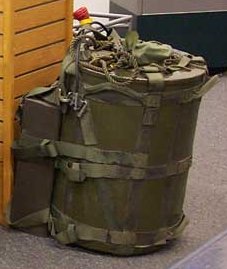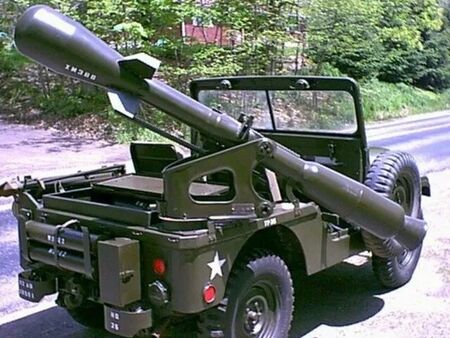Difference between revisions of "Mini-nuke"
(re wording) |
(picture) |
||
| Line 26: | Line 26: | ||
* Aug. 4, 1998 Former GRU Col. Lunev claims that man-portable nuclear devices were built for Soviet special operations forces and that they may have been hidden in the U.S. | * Aug. 4, 1998 Former GRU Col. Lunev claims that man-portable nuclear devices were built for Soviet special operations forces and that they may have been hidden in the U.S. | ||
* Oct. 3, 1998 Yablokov, in U.S. Congressional testimony, claims KGB was primary user for “terroristic” purposes but may no longer be in existence. Lebed, on [[NBC]], claims there may be as many as 500 devices or as few as 100. | * Oct. 3, 1998 Yablokov, in U.S. Congressional testimony, claims KGB was primary user for “terroristic” purposes but may no longer be in existence. Lebed, on [[NBC]], claims there may be as many as 500 devices or as few as 100. | ||
| + | [[File:Davy_Crockett.jpg|right|450px|thumb|Davy Crockett Weapon System]] | ||
* August 1999 Terrorism analyst Yossef Bodansky claims bin Laden has “several” suitcase nuclear devices. | * August 1999 Terrorism analyst Yossef Bodansky claims bin Laden has “several” suitcase nuclear devices. | ||
* Nov. 5, 2001 Lunev claims that bin Laden has obtained several suitcase devices. | * Nov. 5, 2001 Lunev claims that bin Laden has obtained several suitcase devices. | ||
Revision as of 19:56, 9 April 2021
(nuclear weapon) | |
|---|---|
 | |
| Interest of | Alexander Lebed |
| A nuclear device small enough to be carried in a backpack | |
A mini-nuke is a nuclear bomb that generates a smaller explosion than those that are mounted on rockets. These devices are also called "suitcase nuclear device", "backpack nuke" or "pocket nuke". They are in the range of what is referred to as tactical nuclear weapon.
Contents
Missing suitcase nukes from Soviet inventories
In 2001 UPI reported that Alexander Lebed testified in 1997 before a section of the House Armed Services Committee, that "perhaps 100 small nuclear devices were missing from inventories under his control".[1] However, Siegfried S. Hecker, for the Los Alamos National Laboratory in a 2002 Russian-American Workshop, organized by National Research Council and Russian Academy of Sciences, found, that: "the dissolution of the Soviet Union with the consequent loss of order and central government control, especially in the early 1990s, raised the specter of theft or diversion of nuclear weapons or weapons-usable materials from the nuclear complex of the former Soviet Union. Although the “loose-nukes” concern received much play in the American media, it appears overblown. There is no evidence that Russia has lost control of any weapons in its nuclear arsenal.".[2]
Timeline
- April 1995 Russian media reports claim Chechen rebels have “a number” of small nuclear devices (Atomic Demolition Munitions or ADMs)
- January 1996 Monterey Institute of International Studies reports that the KGB had a number of small nuclear devices in the 1970s and 1980s.
- Sept. 1996 Lebed forms commission to review security of Russia’s nuclear arsenal.
- Oct. 17, 1996 Yeltsin fires Lebed. May 1997 Lebed tells U.S. congressional delegation that 84 of 132 “suitcase sized” bombs are missing.
- Sept. 7, 1997 60 Minutes airs Lebed interview in which he claims that more than 100 suitcase nukes are missing out of a total of 250. Russian PM calls allegations “absurd,” Yeltsin’s press secretary attributes comments to Lebed’s political aspirations.
- Sept. 10, 1997 MINATOM: “No such weapons exist.” GRU: suitcase nukes were never produced.
- Sept. 13, 1997 Head of Investigative Commission: No Russian units have ADMs; any such devices are appropriately stored.
- Sept. 22, 1997 Alexei Yablokov, Yeltsin’s former environmental and health advisor, claims, in letter to Novaya Gazeta, to have met the designers of the suitcase nukes and that they were built for the KGB.
- Sept. 25, 1997 Lt. Gen. Igor Valynkin, in charge of protecting Russia’s nuclear weapons, claims ADMs are too expensive to build and maintain; impossible for KGB to have its own nuclear devices. Former Head of the KGB: “KGB had no use for nuclear weapons.” Russian National Security Advisor: “No record of such devices.”
- Sept. 27, 1997 MINATOM: suitcase nukes “never existed, and do not exist.” Federal Security Service: no information on KGB possessing such devices.
- Dec. 1997 Russian Defense Minister tells Rep. Weldon: “Yes we did build them…they will be destroyed by 2000.”
- Aug. 4, 1998 Former GRU Col. Lunev claims that man-portable nuclear devices were built for Soviet special operations forces and that they may have been hidden in the U.S.
- Oct. 3, 1998 Yablokov, in U.S. Congressional testimony, claims KGB was primary user for “terroristic” purposes but may no longer be in existence. Lebed, on NBC, claims there may be as many as 500 devices or as few as 100.
- August 1999 Terrorism analyst Yossef Bodansky claims bin Laden has “several” suitcase nuclear devices.
- Nov. 5, 2001 Lunev claims that bin Laden has obtained several suitcase devices.
- Jan. 17, 2002 Russian Atomic Energy Minister: “all of these [miniature nuclear devices] are registered…it is technically impossible for them to find their way into the hands of terrorists."
Relevant Wikipedia articles
Suitcase nuclear device — Archive.is
Atomic demolition munition — Archive.is
Special Atomic Demolition Munition — Archive.is
Davy Crockett (nuclear device) — Archive.is
W54 — Archive.is
Tactical nuclear weapon — Archive.is
Related Quotation
| Page | Quote | Author | Date |
|---|---|---|---|
| Golan Heights | “But what we also have discovered was that Israel not only has nuclear weapons, but sophisticated tactical nuclear weapons just like we do. Remember the American Army used to have nuclear land mines, for example, all over Germany. Well, the Israelis, we've discovered, have nuclear land mines seated on the Golan Heights and at one point Ariel Sharon, who is, of course, famous for the invasion of Lebanon and whatnot, went to [Menachem] Begin and said, "Look, you're busy," and had a terrible relationship at the time with the chief of Mossad. He wanted to take over sole control of the nuclear button, and Begin, fortunately, said no.” | Leslie Cockburn | 30 July 1991 |
Related Document
| Title | Type | Publication date | Author(s) | Description |
|---|---|---|---|---|
| Document:Dimitri Khalezov Interview | interview | 14 October 2010 | Daniel Estulin Dimitri Khalezov | Daniel Estulin probes the startling claims of Dimitri Khalezov - an ex-Soviet army nuclear weapons specialist - about the events of 9-11 and the then pending extradition of his colleague Victor Bout from Thailand to the USA on arms trafficking charges |
